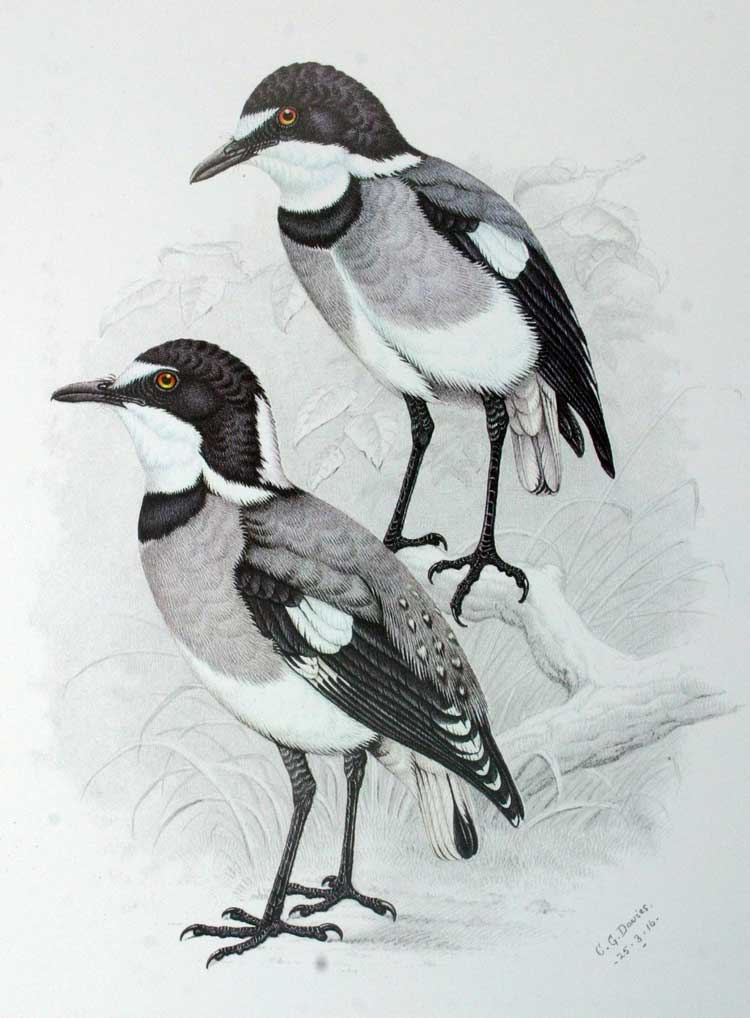
Lanioturdus torquatus, adult male and female
Superregnum: Eukaryota
Cladus: Unikonta
Cladus: Opisthokonta
Cladus: Holozoa
Regnum: Animalia
Subregnum: Eumetazoa
Cladus: Bilateria
Cladus: Nephrozoa
Superphylum: Deuterostomia
Phylum: Chordata
Subphylum: Vertebrata
Infraphylum: Gnathostomata
Megaclassis: Osteichthyes
Cladus: Sarcopterygii
Cladus: Rhipidistia
Cladus: Tetrapodomorpha
Cladus: Eotetrapodiformes
Cladus: Elpistostegalia
Superclassis: Tetrapoda
Cladus: Reptiliomorpha
Cladus: Amniota
Classis: Reptilia
Cladus: Eureptilia
Cladus: Romeriida
Subclassis: Diapsida
Cladus: Sauria
Infraclassis: Archosauromorpha
Cladus: Crurotarsi
Divisio: Archosauria
Cladus: Avemetatarsalia
Cladus: Ornithodira
Subtaxon: Dinosauromorpha
Cladus: Dinosauriformes
Cladus: Dracohors
Cladus: Dinosauria
Ordo: Saurischia
Cladus: Eusaurischia
Subordo: Theropoda
Cladus: Neotheropoda
Cladus: Averostra
Cladus: Tetanurae
Cladus: Avetheropoda
Cladus: Coelurosauria
Cladus: Tyrannoraptora
Cladus: Maniraptoromorpha
Cladus: Maniraptoriformes
Cladus: Maniraptora
Cladus: Pennaraptora
Cladus: Paraves
Cladus: Eumaniraptora
Cladus: Avialae
Infraclassis: Aves
Cladus: Avebrevicauda
Cladus: Pygostylia
Cladus: Ornithothoraces
Cladus: Ornithuromorpha
Cladus: Carinatae
Parvclassis: Neornithes
Cohors: Neognathae
Cladus: Neoaves
Cladus: Telluraves
Cladus: Australaves
Ordo: Passeriformes
Subordo: Passeri
Infraordo: Corvida
Superfamilia: Corvoidea
Familia: Malaconotidae
Genus: Lanioturdus
Species: Lanioturdus torquatus Subspecies: L. t. mesicus - L. t. torquatus
Name
Lanioturdus torquatus Waterhouse, 1838
Vernacular names
español: Laniotordo
References
An expedition...into the interior of Africa, through the... countries of the Great Namaquas, Boschmans, and Hill Damaras 2 App. p. 264
The white-tailed shrike (Lanioturdus torquatus) is a small passerine bird from the family Platysteiridae. It is also known as the chatshrike or ground batis. It occurs only in western Angola and Namibia in thorn scrub. It forages from ground level, where it hops about in large bounds and upright posture, to 25m above ground, scanning for insects. The very short tail, with a small black mark at the tip of the central two feathers, is always carried down, never sticking up. Its range of calls includes loud ringing territorial whistles.
This curious bird, which some consider to have close affinities with the batises and others the bushshrikes, was discovered in 1837 by James Edward Alexander in the Naukluft Mountains of Namibia. Waterhouse subsequently described it in 1838, the name Lanioturdus ('shrike-thrush') reflecting the uncertainty of its classification, and torquatus denoting 'collared'. The sexes have a similar appearance.
It is a common, endemic, breeding resident in the region, small seasonal migrations taking place. Its favoured habitat is scrub-savanna, thornbush and mopane-veld. It is found singly or in pairs during the breeding season, and in small groups at other times. It is a clumsy flier with shallow and rapid wingbeats like other batises.
Nests are usually located in thorny acacias and are constructed by both sexes. Nests are deep, neat well-moulded cups incorporating spider-web and placed about 3 metres above ground. The usual clutch is 2-3 eggs pale-green to white with sparse reddish-brown spots. Only the female incubates the eggs.
References
BirdLife International (2016). "Lanioturdus torquatus". IUCN Red List of Threatened Species. 2016: e.T22707446A94124604. doi:10.2305/IUCN.UK.2016-3.RLTS.T22707446A94124604.en. Retrieved 12 November 2021.
Shrikes of Southern Africa - Tony Harris & Graeme Arnott (Struik Winchester 1988) ISBN 0-947430-08-3
Retrieved from "http://en.wikipedia.org/"
All text is available under the terms of the GNU Free Documentation License

